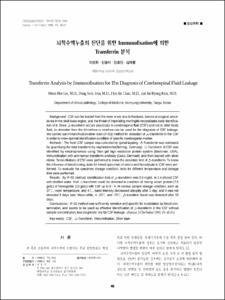KUMEL Repository
1. Journal Papers (연구논문)
1. School of Medicine (의과대학)
Dept. of Laboratory Medicine (진단검사의학)
뇌척수액누출의 진단을 위한 Immunofixation에 의한 Transferrin 분석
- Keimyung Author(s)
- Jeon, Dong Seok; Chun, Hyo Jin; Kim, Jae Ryong
- Department
- Dept. of Laboratory Medicine (진단검사의학)
- Journal Title
- 대한임상병리학회지
- Issued Date
- 1999
- Volume
- 19
- Issue
- 1
- Keyword
- CSF; β2-Transferrin; Immunofixation; Silver stain
- Abstract
- Background : CSF can be leaked from the nose or ear due to fractures, tumors or surgical procedures
in the skull base region, and the threat of impending meningitis necessitates early identification
of it. Since 2-transferrin occurs practically in cerebrospinal fluid (CSF) and not in other body
fluid, its detection from the rhinorrhea or otorrhea can be used for the diagnosis of CSF leakage.
We carried out immunofixation-silver stain (IF-SS) method for detection of 2-transferrin in the CSF
in order to know optimal identification condition of specific cerebrogenic marker.
Methods : The fresh CSF sample was collected by spinal tapping. 2-Transferrin was estimated
by quantifying the total transferrin by nephelomertry(Behring, Germany). 2-Transferrin of CSF was
identified by electrophoresis using Titan gel high resolution protein system (Beckman, USA),
immunofixation with anti-human transferrin antibody (Dako, Denmark) and then stained with silver
nitrate. Serial dilutions of CSF were performed to know the detection limit of 2-transferrin. To know
the influence of blood mixing, tests for mixed specimen of serum and hemolysate in CSF were performed.
To evaluate the specimen storage condition, tests for different temperature and storage
time were performed .
Results : By IF-SS method, identification limit of 2-transferrin was 0.5 mg/dL in 1:4 diluted CSF
with distilled water. And 2-transferrin could be detected in condition of mixing serum protein (7.5
g/dL) or hemoglobin (13 g/dL) with CSF up to 6 : 4. At various sample storage condition, such as
37℃, room temperature, and 4℃, band intensity decreased abruptly after 1 day, and it was not
detected 5 days later. Mean while, in -20℃ and -70℃, 2-transferin band was detected after 10
days.
Conclusionss : IF-SS method was sufficiently sensitive and specific for invalidation by blood contamination,
and seems to be used as effective identification of 2-transferrin in the CSF without
sample concentration, less diagnostic test for CSF leakage.
배경 : 두개골 골절, 종양, 외과적 치료에 기인한 뇌척수액의
유출은 뇌수막염을 유발할 위험성이 많아 초기에 진단하는 것이
임상적으로 매우 중요하다. β2-transferrin은 다른 체액에는 존재
하지않고 주로 뇌척수액에 존재함므로, 이루나 비루에서 뇌척수액
유출을 진단하는데 사용될수 있다. 이에 본 연구에서는 면역고정
후 β2-transferrin을 은염색(silver stain)하여 뇌척수액누출을 검
출하고자 하였으며 아울러 검체보관조건 및 혈액의 오염이 검사
에 미치는 영향 등 검체의 적정 조건을 알아보고자 하였다
방법 : 검체는 척추천자하여 얻어진 신선한 뇌척수액을 대상으
로 하였으며, 총 transferrin치는 nephelometry (Berhing, 독일)
로 측정하였다. β2-transferrin 의 측정은 high resolution protein
kit (Beckman사, 미국)을 이용하여 뇌척수액을 전기영동한 후 항
인 transferrin으로 면역고정하고 은염색하였다. 이 방법의 β2-
transferrin 검출한계를 알아보기 위하여 뇌척수액을 계단희석하
여 검사하였다. 혈액의 오염이 IF-SS법에 미치는 영향을 알아보
기 위하여 뇌척수액에 용혈물(hemolysate)과 혈청을 일정한 부
피 비로 혼합하여 검사하였으며, 검체 보관조건에 따른 영향을
보기 위하여 온도 및 보관시간을 다르게 하여 검사하였다.
결과 : 뇌척수액에서의 β2-transferrin의 동정한계는 0.5 mg/dL였고 이때 뇌척수액의 희석배수는 1:4 정도였다. 혈청 단백 (7.5
g/dL)과 Hb (13 g/dL)이 6:4 이하로 혼합된 경우에서 β2-transferrin을
관찰할 수 있었다. 37℃, 실온, 4℃에 보관시에는 보관 1
일째에 β2-transferrin band의 강도가 급격히 감소하였으며 5일
째 이후부터는 band의 판독이 곤란하였다. 반면에 -20℃와 -70℃
에서는 10일째 이후에도 β2-transferrin band의 반응강도가 비교
적 뚜렷하여 판독에 어려움은 없었다
결론 : IF-SS법은 뇌척수액에 존재하는 β2-transferrin에 특이
적인 반응을 보였고 검체를 농축하지 않고 미량의 뇌척수액에서
도 양성반응을 보였으며 혈액의 오염이 검사에 미치는 영향이 적
어서 뇌척수액누출의 진단에 유용할 것으로 사료된다.
- Alternative Title
- Transferrin Analysis by Immunofixation for The Diagnosis of Cerebrospinal Fluid Leakage
- Publisher
- School of Medicine
- Citation
- 이문희 et al. (1999). 뇌척수액누출의 진단을 위한 Immunofixation에 의한 Transferrin 분석. 대한임상병리학회지, 19(1), 46–51.
- Type
- Article
- ISSN
- 1015-6445
- Appears in Collections:
- 1. School of Medicine (의과대학) > Dept. of Laboratory Medicine (진단검사의학)
- 파일 목록
-
-
Download
 oak-bbb-3408.pdf
기타 데이터 / 248.3 kB / Adobe PDF
oak-bbb-3408.pdf
기타 데이터 / 248.3 kB / Adobe PDF
-
Items in Repository are protected by copyright, with all rights reserved, unless otherwise indicated.